Reichenbach im Vogtland
Reichenbach im Vogtland is a town in the Vogtlandkreis district of Saxony, Germany. With a population of 20,928 (2017-09-30),[2] it is the second largest town in the Vogtlandkreis after Plauen. It lies by the A72 between Plauen (at c. 18 km) and Zwickau (at c. 19 km).
Reichenbach im Vogtland | |
|---|---|
 Coat of arms | |
Location of Reichenbach im Vogtland within Vogtlandkreis district 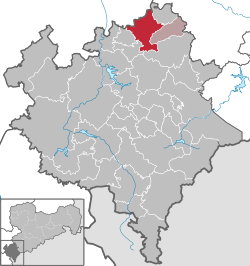 | |
 Reichenbach im Vogtland 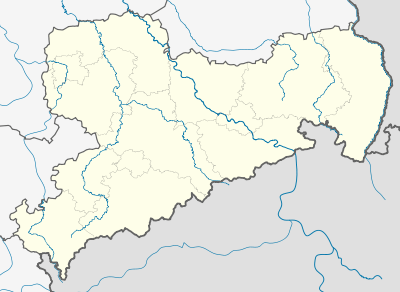 Reichenbach im Vogtland | |
| Coordinates: 50°37′N 12°18′E | |
| Country | Germany |
| State | Saxony |
| District | Vogtlandkreis |
| Municipal assoc. | Heinsdorfergrund |
| Government | |
| • Mayor | Raphael Kürzinger (CDU) |
| Area | |
| • Total | 34.46 km2 (13.31 sq mi) |
| Elevation | 380 m (1,250 ft) |
| Population (2018-12-31)[1] | |
| • Total | 20,625 |
| • Density | 600/km2 (1,600/sq mi) |
| Time zone | CET/CEST (UTC+1/+2) |
| Postal codes | 08468, 08491 (Jägerhaus), 08499 (Mylau, Obermylau) |
| Dialling codes | 03765 |
| Vehicle registration | V, AE, OVL, PL, RC |
| Website | www.reichenbach-vogtland.de |
History
Reichenbach im Vogtland originated as a settlement of the Franks and thanks its early growth to its convenient position in a valley near Mylau Castle. In 1212 it was officially named Richenbach, possibly because of the many wetland basins (German: Bächen) in the area which now hosts the Altstadt. It received town privileges around 1240 and was mentioned in 1271 in a decree as "civitatis richenbach", a recognized small city with autonomous rights to defend itself, trade and hold municipal elections. Much of the Reichenbach history was lost in the city fires of 1720, 1773, and 1833. The foundations of the Peter Paul parish church still date back to the 12th century.
The rise of industrialisation allowed the city to grow further, again promoted by its accessibility. Sewing and weaving were Reichenbach's main trades, but in the 19th century the metal working industry settled in the city and in the early 20th century, there was a rise of the pulp and paper industry and printing works. Some of Reichenbach's most remarkable structures date from this era, including its Rathaus (1837–1839), the railway station (1846), and world's largest brick bridge, the Göltzsch Viaduct (1846–1851).
Reichenbach im Vogtland has had a rather insignificant role in World War II. On March 21, 1945, American bombings killed 161 citizens and destroyed or damaged many buildings.[3] Against the orders of the National Socialists, Mayor Dr. Otto Schreiber capitulated the city on April 17 without a fight. The town was occupied by American troops, who handed over control to the Red Army on July 1. About 120 innocent youth aged 15 and 16 were taken in custody and transferred to the Soviet Union's secret service (predecessor of the KGB), hoping all other citizens would be spared.
After Germany was split up, Reichenbach im Vogtland became part of East Germany. The population has since declined from nearly 35,000 to little over 20,000 today. As was the case with many former East German industrial cities, the 1991 German reunification caused many workers to lose their jobs and they started to move away. Many initiatives have since been deployed to rebuild the local economy. There are still many industrial buildings in Reichenbach with a high historic value, but with little appeal.
The administrative district of Reichenbach has grown since the early 20th century to include the quarters and villages of Brunn (1994), Cunsdorf (1924), Friesen (1994), Mylau (2016), Obermylau (2016), Oberreichenbach (1908), Rotschau (1996), and Schneidenbach (1999), and has had a collaborative relationship with Heinsdorfergrund since 2000.[4][5][6] Schneidenbach kam am 1. Januar 1999 hinzu.[7][8]
Historical population
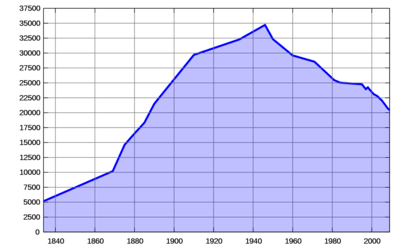
|
|
|
Sites of interest
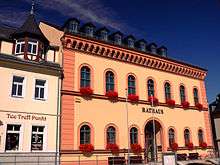
.jpg)
- Reichenbach station is part of the Leipzig–Hof line. This line includes the Göltzsch Viaduct, the largest brick bridge in the world, which lies 4 km (2.5 mi) west of the town.
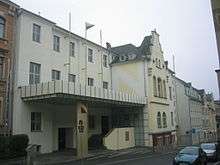
- The Neuberinhaus is a local historical and theatrical museum, named after the town's most famous citizen, actress Friederike Caroline Neuber (1697–1760), nicknamed "the Neuberin". Permanent expositions include her life and work, 18th century German theatre and the town's history.

- The Park der Generationen (Park of Generations), the gardens of the 5th Saxon Landesgartenschau (horticultural show) held between May 1 and October 18, 2009.
Communications
Reichenbach im Vogtland also has a telecommunication tower of Deutsche Telekom erected out of concrete, which includes a VHF broadcasting station for among others Vogtlandradio. It is not to be confused with the tower in Reichenbach (Oberlausitz) which transmits MDR Info at 1,188 kHz.
Education
The Westsächsische Hochschule Zwickau - University of Applied Sciences Zwickau teaches Architecture at bachelor and master level and Textile- and Leather Craftsmanship. The city also has a gymnasium, a middle school, three primary schools, and a special school for the physically and mentally challenged. Middle school students also attend schools in the surrounding towns.
People
- Georg Lenck (1685–1744), musician
- Friederike Caroline Neuber (1697–1760), actor and director
- Karl Böttiger (1760–1835), archaeologist and classicist
- Johann Friedrich Krause (1770–1820), theologian
- Fedor Flinzer (1832-1911), author, educator, and illustrator
- August Horch (1868–1951), automobile pioneer
- Richard Benz (1884–1966), historian
- Rudolf Krause (1907–1987), racing driver
- Karl Nitz (1938-), judo athlete
- Josef Bachmann (1944–1970), activist
- Jürgen Fuchs (1950–1999), author and DDR dissident
- Henry Stöhr (1960-), judo athlete
References
- "Bevölkerung des Freistaates Sachsen jeweils am Monatsende ausgewählter Berichtsmonate nach Gemeinden" (PDF). Statistisches Landesamt des Freistaates Sachsen (in German). July 2019.
- "Bevölkerung des Freistaates Sachsen jeweils am Monatsende ausgewählter Berichtsmonate nach Gemeinden" Statistisches Landesamt des Freistaates Sachsen. June 12th 2018. (in German)
- Excerpt from Reichenbach im Vogtland of the Reichenbach Seniors Computer Club. (in German)
- Reichenbach in the Digital Historic Index of Places in Saxony (Digitales Historisches Ortsverzeichnis von Sachsen)
- Gemeinden 1994 und ihre Veränderungen seit 01.01.1948 in den neuen Ländern, Verlag Metzler-Poeschel, Stuttgart, 1995, ISBN 3-8246-0321-7, Herausgeber: Statistisches Bundesamt
- StBA: Änderungen bei den Gemeinden Deutschlands, siehe 1996
- StBA: Änderungen bei den Gemeinden Deutschlands, siehe 1999
- Genehmigung der Vereinigung der Städte Reichenbach im Vogtland und Mylau zur neuen Stadt Reichenbach im Vogtland vom 30. November 2015, retrieved, 1 January 2016
External links
- Official website

- Local churches and denominations (in German)
.jpg)